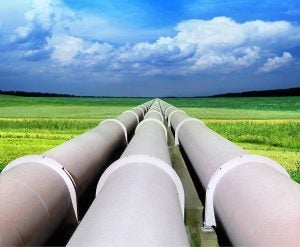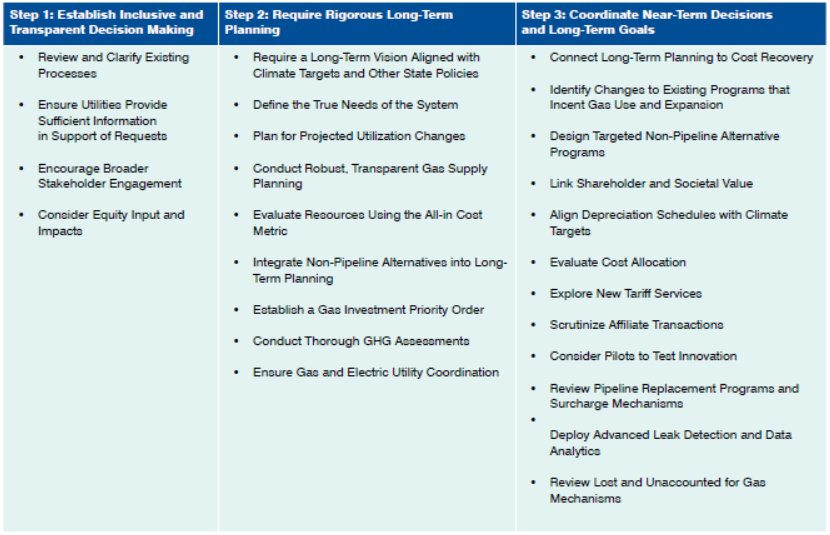What our climate goals mean for natural gas, and what states should do about it
 The transition to a low-carbon economy will have a big impact on the way we think about natural gas: how we produce, use and transport it. One area where this challenge is particularly acute is the state regulatory frameworks governing gas utilities across the country, and in particular, how those rules line up against the climate goals now being set by a growing number of states.
The transition to a low-carbon economy will have a big impact on the way we think about natural gas: how we produce, use and transport it. One area where this challenge is particularly acute is the state regulatory frameworks governing gas utilities across the country, and in particular, how those rules line up against the climate goals now being set by a growing number of states.
States that don’t re-envision the way their gas utility systems run will be challenged to meet their climate targets. To help states avoid that fate, EDF has developed a new guide suggesting ways that state regulators can navigate this complex challenge.
States in the hot seat
California, Colorado, New York and Massachusetts all have ambitious, science-based goals to decarbonize their energy systems. Over the past year, each has started proceedings to revisit the way they regulate and manage the incredibly complex systems that deliver gas to millions of homes and businesses.
What our climate goals mean for natural gas, and what states should do about it Share on XThe problem is that natural gas — which is mostly methane — is a potent climate pollutant. When it escapes into the atmosphere unburned, it has more than 80 times the 20-year warming power of carbon dioxide. The natural gas system, all the way from wells in the field to the service lines under your local streets, releases enormous amounts of methane. When burned, natural gas releases carbon dioxide. Combustion of natural gas for heating and cooking in buildings produces about 10% of total U.S. carbon emissions.
To meet their climate goals, states need to reduce methane emissions from gas systems while simultaneously reducing the amount of gas they use. Unfortunately, current policies often do just the opposite.
For instance, the New York Public Service Commission has an explicit policy to foster the use of more gas. Every year the commission asks gas utilities to detail their expansion projects. If there are none, the state asks why, “given the commission’s stated goal of expanding the gas system in New York State.” Gas utilities are effectively expected to propose expensive new projects, without considering how long those projects will be needed or whether they run counter to the state’s climate objectives.
Perhaps that system worked when gas was viewed as a cost-effective alternative to fuels such as oil, and when its environmental downside was unknown or unacknowledged. However, today we have a vast menu of options to meet our energy needs — everything from wind and solar to energy efficiency and heat pumps. Moreover, as we plan for a more renewable system and increased electrification of buildings, natural gas infrastructure that might once have been deemed useful may no longer be needed for our future system.
This presents a challenging economic problem. As the customer base for natural gas shrinks, the cost of building, operating and maintaining gas infrastructure is spread over fewer and fewer people, raising the costs for a shrinking group of gas customers that remain. As we overhaul the system, we need to do so in a way that does not place undue financial stress on those remaining customers. Regulators will need to thoughtfully consider the existing financial obligations of the gas system and manage its contraction so that these critical equity considerations are taken into account.
Road map for regulators
Governing in this new era requires both procedural changes (such as more inclusive proceedings that incorporate robust stakeholder input) and substantive ones (such as enhanced regulatory oversight to prevent gas assets from becoming stranded). We must also consider who will be using the system, and who will be paying for it going forward, to ensure an equitable transition to cleaner forms of energy.
Our new guide for state policymakers offers a road map to bridge the disconnect between gas regulation and climate commitments. It sets forth 25 different recommendations based on EDF’s experience engaging in gas regulatory proceedings across the country, as well as early-stage activities underway in certain states.
The recommendations are broadly organized into three categories:
- Inclusive and transparent decision-making.
- Rigorous long-term planning.
- Coordination of near-term decisions and long-term goals.
While it may not be feasible to implement all of these recommendations simultaneously, a crucial first step will be to establish a holistic gas-planning docket and require gas utilities to make thorough and transparent filings regarding future planning activities.
Implementing these recommendations will provide greater visibility and clarity into the regulatory process, avoid sub-optimal outcomes with respect to customer cost and long-term system planning, and protect against unneeded investments that could result in the imposition of stranded costs. EDF looks forward to engaging with stakeholders on these and other solutions to determine how states can best tackle the challenges of the energy transition.











